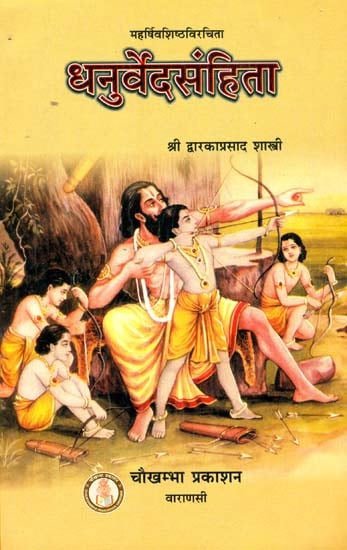Dhanurveda Samhita [sanskrit]
3,015 words
The Sanskrit text of the Dhanurveda-samhita attributed to Vasishtha. Dhanur Veda is a type of ancient India science whose roots date to the 2nd millenium BCE. It is counted among the Upavedas literature. This specific version of the Dhanurveda contains roughly 240 sections of Sanskrit text.
Verse 1.7
आचार्य्येण धनुर्द्देयं ब्राह्मणे सुपरीक्षिते ।
लुब्धे धूर्त्ते कृतघ्ने च मन्दबुद्धौ न दापयेत् ॥ ७ ॥
ācāryyeṇa dhanurddeyaṃ brāhmaṇe suparīkṣite |
lubdhe dhūrtte kṛtaghne ca mandabuddhau na dāpayet || 7 ||
Note! The following is not a translation of the above verse, but merely an arbitrary extract of the English text.
The acarya should give the bow to a well-examined brahmana. One should not give charity to a greedy, cunning, ungrateful or dull-witted person.
English translation by Hardayalu Swami (2001) Buy now!
Glossary of Sanskrit terms
Note: This extracts Sanskrit terms and links to English definitions from the glossary, based on an experimental segmentation of verse (1.7). Some terms could be superfluous while some might not be mentioned. Click on the word to show English definitions.
Aca, Aryi, Ena, Brahmana, Suparikshita, Lubdha, Tta, Tti, Kritaghna, Mandabuddhi,
Analysis of Sanskrit grammar
Note: this is an experimental feature and only shows the first possible analysis of the Sanskrit text (Verse 1.7). If the system was successful in segmenting the sentence, you will see of which words it is made up of, generally consisting of Nouns, Pronouns, Verbs, Participles and Indeclinables. Click on the link to show all possible derivations of the word.
- Line 1: “ācāryyeṇa dhanurddeyaṃ brāhmaṇe suparīkṣite ”
- ācā -
-
āca (noun, masculine)[compound], [vocative single]√ac (verb class 1)[perfect active first single], [perfect active second plural], [perfect active third single]
- aryye -
-
aryī (noun, feminine)[compound], [adverb], [nominative single], [vocative single]
- eṇa -
-
eṇa (noun, masculine)[compound], [vocative single]
- Cannot analyse dhanurddeyam*br
- brāhmaṇe -
-
brāhmaṇa (noun, masculine)[locative single]brāhmaṇa (noun, neuter)[nominative dual], [vocative dual], [accusative dual], [locative single]brāhmaṇā (noun, feminine)[nominative dual], [vocative single], [vocative dual], [accusative dual]
- suparīkṣite -
-
suparīkṣita (noun, masculine)[locative single]suparīkṣita (noun, neuter)[nominative dual], [vocative dual], [accusative dual], [locative single]suparīkṣitā (noun, feminine)[nominative dual], [vocative single], [vocative dual], [accusative dual]
- Line 2: “lubdhe dhūrtte kṛtaghne ca mandabuddhau na dāpayet ”
- lubdhe -
-
lubdha (noun, masculine)[locative single]lubdha (noun, neuter)[nominative dual], [vocative dual], [accusative dual], [locative single]lubdhā (noun, feminine)[nominative dual], [vocative single], [vocative dual], [accusative dual]√lubh -> lubdha (participle, masculine)[locative single from √lubh class 4 verb], [locative single from √lubh class 6 verb]√lubh -> lubdha (participle, neuter)[nominative dual from √lubh class 4 verb], [vocative dual from √lubh class 4 verb], [accusative dual from √lubh class 4 verb], [locative single from √lubh class 4 verb], [nominative dual from √lubh class 6 verb], [vocative dual from √lubh class 6 verb], [accusative dual from √lubh class 6 verb], [locative single from √lubh class 6 verb]√lubh -> lubdhā (participle, feminine)[nominative dual from √lubh class 4 verb], [vocative single from √lubh class 4 verb], [vocative dual from √lubh class 4 verb], [accusative dual from √lubh class 4 verb], [nominative dual from √lubh class 6 verb], [vocative single from √lubh class 6 verb], [vocative dual from √lubh class 6 verb], [accusative dual from √lubh class 6 verb]
- dhūr -
-
dhur (noun, feminine)[compound]
- tte -
-
tta (noun, masculine)[locative single]tta (noun, neuter)[nominative dual], [vocative dual], [accusative dual], [locative single]ttā (noun, feminine)[nominative dual], [vocative single], [vocative dual], [accusative dual]tti (noun, feminine)[vocative single]
- kṛtaghne -
-
kṛtaghna (noun, masculine)[locative single]kṛtaghna (noun, neuter)[nominative dual], [vocative dual], [accusative dual], [locative single]kṛtaghnā (noun, feminine)[nominative dual], [vocative single], [vocative dual], [accusative dual]
- ca -
-
ca (indeclinable conjunction)[indeclinable conjunction]ca (noun, masculine)[compound], [vocative single]ca (noun, neuter)[compound], [vocative single]
- mandabuddhau -
-
mandabuddhi (noun, masculine)[locative single]mandabuddhi (noun, feminine)[locative single]
- na -
-
na (indeclinable particle)[indeclinable particle]na (noun, masculine)[compound], [vocative single]na (noun, neuter)[compound], [vocative single]
- dāpayet -
-
√dā (verb class 0)[optative active third single]
Other editions:
Also see the following editions of the Sanskrit text or (alternative) English translations of the Verse 1.7
Dhanurveda Samhita (धनुर्वेदसंहिता)
by Hardayalu Swami (2001)
Publisher: Khemraj Shrikrishnadass
Buy now!
Vasistha’s Dhanurveda Samhita
by Purnima Ray (2023)
Publisher: Khemraj Shrikrishnadas; ISBN-10: 818670289X; ISBN-13: 9788186702895; 88 pages including 18 illustrations;
Buy now!
Dhanurveda Samhita (धनुर्वेदसंहिता) (संस्कृत एवं हिंदी अनुवाद)
by Shri Dwarka Prasad Shastri (2007)
Title: Dhanurveda Sanhita (Hindi translation); Publisher: Chaukhambha Prakashan, Varanasi; 84 pages including 11 illustrations; Author: महर्षि वशिष्ठ (Maharshi Vashistha); Foreword by Dr. Chakradhar Bijalwan.
Buy now!![Dhanurveda Samhita [sanskrit] - book cover](/uploads/a/Dhanurveda-Sanskrit.jpg)

